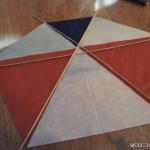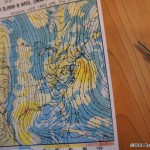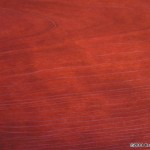When we make art, or kites, it’s often a convergence of factors that guides our creativity. Sewing skill, access to materials, travel: all of these can influence the next end product.
In my own artistic endeavors this is easily demonstrated; I’ve practiced piecing paper for a variety of effects, I have access to imported bamboo, and I’ve been fortunate to see excellent kites from around the world.
These factors have led me to make a series of kites thought to be American in origin, classic barn-door and three-stick kites. But the last piece in the convergence of factors was a book about Francis Beaufort, inventor of the Beaufort Scale of wind force (Defining the Wind: The Beaufort Scale and How a 19th-Century Admiral Turned Science into Poetry, Scott Huler).
Inspired by the similarity between wood grains and the lines on NOAA wind charts, I assembled the kites with embossed woodblock prints. Some are reminiscent of three-stick kites seen in newspaper and magazine prints of 100 years ago, while others are original variations (one is a paper adaptation of a French KAP kite of the early 1900s).
At any rate, there is a point to talking about convergences. It is an exciting time at the Drachen Foundation as we work frantically to digitize our entire collection and archive. The reason is that various technologies have converged to allow us to present our entire 15 year history in a cogent and easy-to-navigate format (interesting how we use a nautical term to describe our movement in websites). The past years have been wonderful.
To know about something one must study it, and that has been the worthy process that Drachen has pursued these last 15 years. We’ve traveled the world and combed almost every corner to learn about the kites and the people who are responsible for them. These years have taken us to some very interesting places and given us a contact list in every possible language.
It was all terrific and our warehouse and computer hard disks are bursting with the documented results. We did the best we could to maintain the collections, housing them in very affordably creative ways. Space is always the issue, whether it is your own office or rented space. The question always remains, what does one do with all these items— memories in the form of photos, DVDs, prints, slides, videos, drawings, kites, accessories, ephemera and writings?
Then it happened, foundation administrator, Ali Fujino, and I were dragged, “kicking and screaming” into the age of the internet when we started to post Foundation activities on the internet. We have since found, of course, that this is the window that most people choose to look through when finding the Drachen Foundation.
Internet activity has shown us that our biggest audience is teachers – those looking for exciting classroom activities or cultural and artistic complements to their curricula – so we need to be concerned with their usage while also serving the kite community at large.
Readers of Kitelife know the ease of delivery of the online magazine, and it’s this ease of use that we are working toward for the Drachen Foundation. For over ten years, we have patched new technology onto the antique framework of our website. It is time for us to embrace new technology (like Druple) that can actively search every word of our website as well as direct readers to other online resources. This is the original mandate for the Drachen Foundation; to disseminate information about the art, science, culture, and history of kites.
We plan to introduce the new website by April 1st and ask kite enthusiasts to take a serious look and offer feedback. We anticipate that the process will take all of 2011 and we will be constantly adding and “filling holes” in our informational database. Certainly one factor in this push is the expense of maintaining a stable archive and collection. We are grant finalists in two archive grants, but these are double-edged swords: for every dollar they might grant us, we will need to invest two or three dollars to complete their directives. Maintenance costs for any collection, museum quality or otherwise, continue to rise, and even established museums are selling portions of their collections, asking for paid membership, and soliciting money from benefactors.
Our move to a totally accessible online collection and archive is a first step in making the Foundation permanent and dynamic even if our resources are reduced.
Readers of Kitelife are the first to know of these plans and I encourage any of you to direct questions and comments to information@drachen.org. Join Drachen as we work to expand beyond a single private collection and offer on-line access to kite collections, resources, and information from throughout the world kite community.
Scott Skinner



